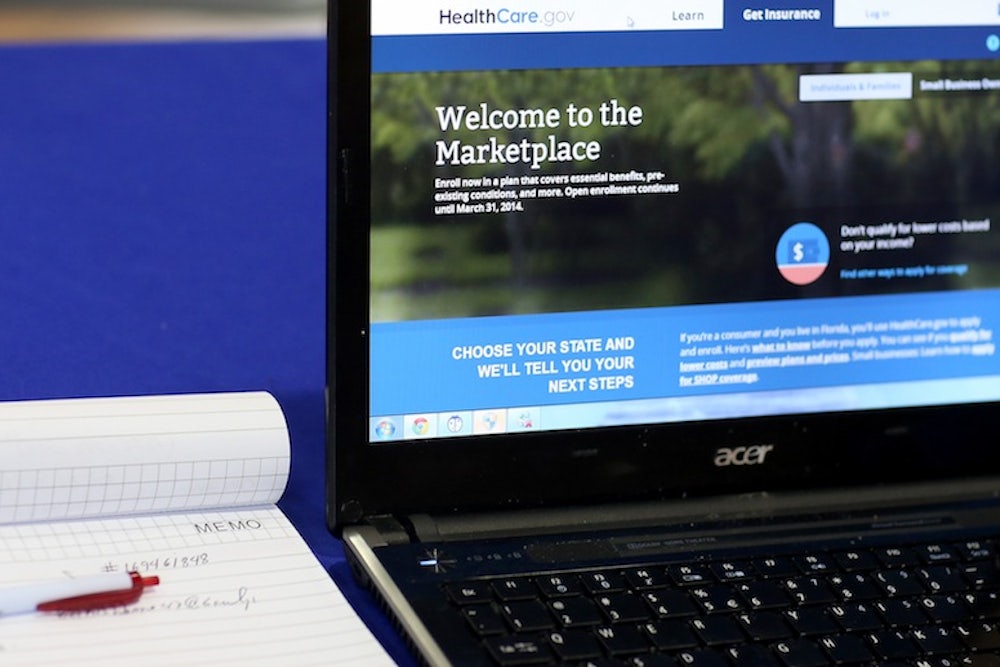Today the government releases some important information about who has health insurance and who doesn’t. But the data is sure to create a lot of confusion, particularly when it comes to Obamacare.
The first set of data came out at midnight, when the U.S. Centers for Disease Control published some results from the National Health Insurance Survey. This “early release” of NHIS data covers the first three months of 2014, which means it includes part of the Affordable Care Act’s open enrollment period—providing a glimpse of how well the law’s coverage expansion worked. The results? The number of people without health insurance fell by 3.8 million people, relative to what the NHIS measured one year ago at the same time.
Critics will say that the number, though significant, falls short of expectations. And it’s true: The Congressional Budget Office and other experts had predicted the Affordable Care Act would reduce the number of uninsured in 2014 by several million more, in addition to the young people who already got insurance. But, as Sabrina Tavernise explains at the New York Times, the timing means this set of NHIS data didn’t capture most of the late enrollment surge that basically doubled enrollment in the Obamacare exchanges. As Harvard economist Katherine Baicker told Tavernise, the NHIS results sound “reasonably consistent with what had been expected,” given what private surveys like those from Gallup and the Urban Institute have already shown.
Later Tuesday, the Census Bureau will release its annual report on poverty and health insurance status. The main results will be about 2013, not 2014, but they are likely to create confusion anyway. That’s because the Census Bureau this year decided to change the questions it asks as part of its main survey, the Current Population Survey, or CPS. The goal was to eliminate the ambiguity of the old questions. But it was a controversial decision and the new system is likely to produce different estimates than the old system did, fostering misimpressions about what happened to health insurance last year.
(Oh, and just to make things really confusing, the Census Bureau may also release its own snapshot of the first quarter of 2014, using yet another survey to offer an early peek at Obamacare progress—although, like the NHIS data, it would probably not include the late enrollment surge.)
The Kaiser Family Foundation has a primer on the different surveys and what they measure. The Center on Budget and Policy Priorities has its own report on the recent changes to the CPS, and how to account for them. Read one or both if you plan on reading the government surveys yourself. And if not? Then just remember to read Tuesday's news carefully. You can count on a lot of people, particularly those critical of Obamacare, to get the story wrong.
The news
CHILD CARE: The House passed a bill reauthorizing the Child Care and Development Block Grant, which subsidizes child care for low-income families. The Senate passed a similar bill earlier this year and, in a rare show of bipartisanship, the two chambers have agreed on a final compromise version. It will include new, if still modest safety and quality requirements—and represents what is likely the final big legislative achievements for Senator Tom Harkin and Congressman George Miller, two Democrats retiring this year. (Maggie Severns, Politico)
POVERTY: The Census Bureau is also releasing new data on poverty today. Jared Bernstein explains how to interpret the new data. (The Upshot)
REGULATION: A major New York Times investigation into the National Highway Transportation Agency finds incredibly lax enforcement of different rules and insufficient resources to adequately investigate crashes. One disturbing finding: When the agency asks automakers about a deadly crash, the question "What may have caused the accident?" is optional. (Hilary Stout, Danielle Ivory and Rebecca R. Ruiz)
EDUCATION: The Texas Board of Education seems to be leaning toward picking social studies textbooks for public schools that claim scientists aren't sure whether human activity is really causing climate change. (Clare Foran, National Journal)
COAL MINERS: The rate of black lung disease in coal miners today is ten times higher than it was in the late 1990s. A new report assigns blame to coal companies for failing to use proven technology to protect workers. (Chris Hamby, BuzzFeed)
EQUAL PAY: The Paycheck Fairness Act still can't break through Republican gridlock in the Senate, after four tries. (Laura Bassett, Huffington Post)
Things worth reading
Don't despair yet on the climate: Everything about world negotiations to act on climate change can seem hopeless. Jeff Goodell offers three compelling reasons to think a meaningful agreement is still possible. (Rolling Stone)
This is what Obamacare means. Ian Millhiser writes about Jennifer Causor, who suffers from cystic fibrosis and depends upon the Affordable Care Act to pay for the transplant drugs keeping her alive. (ThinkProgress)
Stories we're watching:
The new poverty and insurance data from the Census Bureau. The Federal Open Market Committee also has the first of two days of meetings to set monetary policy. And will there be more news from the NFL?
At QED:
Obama's last, best chance to fight climate change starts next week in New York City. Rebecca Leber has a preview. Danny Vinik reminds us that state and local taxes are much more regressive—and punishing to the poor—than federal taxes. Jonathan Cohn thinks the NFL owes domestic violence victims a big, fat check.
